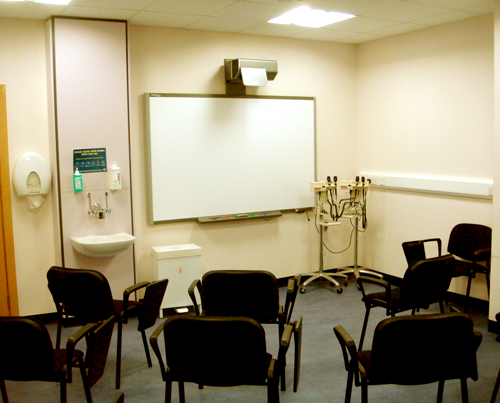The Lothian Optometry Teach and Treat (LOTT) Clinic is a supervised training clinic for community optometrists with an interest in managing patients with acute eye pathology, normally managed in the hospital setting.
LOTT, which is the first clinic of its kind in the UK, was opened in 2010 as a joint venture between NHS Lothian and NHS Education for Scotland (NES). It provides a purpose built and newly equipped facility enabling optometrists to be taught in both clinic and classroom settings. Under the supervision of a consultant ophthalmologist, community optometrists diagnose and manage patients with acute problems. LOTT’s aim is the transference of these diagnostic skills to the community setting, leading to improved patient care and a reduction in unnecessary referrals to busy hospital eye services (HES).
Background
Over the last few years demands on ophthalmic outpatient services have increased, with an inevitable impact on waiting times. Accurate referrals from the community are of vital importance when triaging new patients and a good quality referral allows for both accurate prioritisation and safe discharge of those patients who do not need to be seen by an ophthalmologist. A new electronic referral pathway has been recently introduced in NHS Lothian in an attempt to streamline the referral process from optometrists to HES. This ‘E-triage’ system uses a national standardised electronic referral form which reduces the paper trail and minimises delays seen in the current system.
The main source of referral to HES is the community optometrist. In their every day practice, community optometrists generally see healthy patients and patients with genuine pathology are uncommon. There can be uncertainty in investigating, diagnosing and prioritising these patients and many optometrists are understandably uncomfortable managing patients with pathology. Once a referral is made, the optometrist is often none the wiser about the patient’s clinical course until, at best, they receive a letter six to eight weeks later when the patient has been discharged or a diagnosis and management plan have been implemented. Feedback from HES can be poor and so optometrists are often left oblivious to missed clinical signs or misdiagnoses. Without an open forum for discussion between optometrists and ophthalmologists simple mistakes leading to poor referrals can and often do recur.
LOTT ultimately aims to improve care of patients with acute eye problems in NHS Lothian. Teaching clinics, led by consultant ophthalmologists, are aimed at improving the clinical competency and confidence of optometrists, which should in turn improve the quality of referral to HES and allow some patients to be safely and confidently managed in the community.
Figure 1: Each consultant led teaching session finishes with
feedback and a group discussion in the seminar room.

Figure 2: One of the six custom built examination rooms showing a slit-lamp
with teaching eyepiece and the Eyesi Indirect Ophthalmoscope.
Review of optometry referrals to the Acute Referral Clinic, Edinburgh
A recent audit [1] of referrals from optometrists to the ophthalmology Acute Referral Clinic (ARC) at the Princess Alexandra Eye Pavilion in Edinburgh has highlighted that there is a need to improve the clinical and diagnostic skills of optometrists. The review looked at 50 sets of clinical notes from the ARC and compared the optometrist’s referral letter to the corresponding ophthalmology review (normally a trainee or associate specialist doctor). It showed that whilst the majority of referrals were appropriate, about one third (34%) of the cases could have been assessed and managed by an optometrist and / or other screening services (these patients included normal variants, posterior vitreous detachments, dry age-related macular degeneration, retinoschisis and subconjunctival haemorrhage). Half (50%) of diagnoses made by optometrists in the referral letter were accurate. In 46% of cases, clinical signs that were used by the ophthalmologist to aid their diagnosis were not commented upon (such as anterior chamber cells in anterior uveitis and the presence or absence of tobacco dust in a possible retinal detachment).
“Teaching clinics, led by consultant ophthalmologists, are aimed at improving the clinical competency and confidence of optometrists, which should in turn improve the quality of referral to HES and allow some patients to be safely and confidently managed in the community.”
How it works
Attendance at LOTT is voluntary for optometrists who can use clinical experience gained towards their Independent Prescribing qualification or purely gain experience and enhance their clinical skills. Six sessions a week each accommodating one to five optometrists are run, allowing for close supervision, training and personal feedback. Each session lasts three and a half hours, during which time each optometrist will see an average of five patients (range three to seven) and discuss these with the supervising ophthalmologist. Patients are triaged out of the pool of acute patients seen at the hospital, providing an accurate reflection of referrals from the community. All patients are fully assessed by the optometrist who measures visual acuity and intraocular pressure as well as performing an anterior segment and fundal examination followed by visual field tests or an optical coherence tomography (OCT) scan if required.
Depending on clinical findings they formulate a management plan and dictate a letter to the patient’s GP. At the end of each session 45 minutes is allocated for a group discussion. This typically focuses on interesting cases or particular problems identified during the clinic. Each optometrist can sign up for a minimum of four clinics, usually over consecutive weeks, allowing for an opportunity to follow-up patients, review management plans and manage complications.
Soon, there will also be the opportunity to sit with the consultant ophthalmologist and assist whilst referrals from the community are triaged using the new e-triage system. The aim of assisting with referral triage is to improve each optometrist’s own referrals by gaining an appreciation of what makes a good or a bad referral, as well as common areas in the referral process that could be improved. Each referral can also be used in its own right as a clinical case, broadening exposure to the variety of acute pathologies seen in HES.
The £500,000 facility has been built on the ground floor at the Lauriston Buildings in Edinburgh, across the road from the NHS Lothian Department of Ophthalmology at the Princess Alexandra Eye Pavilion. There are six custom-built clinical examination rooms with slit-lamps with either a teaching eye-piece or video screen attached to each. There is a HiRes OCT scanner, a Humphrey Visual Field machine and the facility to photograph the anterior and posterior segments. There is also a seminar room for teaching and providing feedback during clinics and for group tutorials and discussion. One room contains an EyeSi Indirect Ophthalmoscope Simulator – a virtual reality training simulator that has been developed for use as a training tool for indirect ophthalmoscopy. Part of the EyeSi Indirect software is a computer learning database which supplies a question bank based on clinical cases which can be used as an adjunct to clinical and tutorial based teaching.
The Future
By exposing as many optometrists in Lothian as possible to clinics in LOTT it is hoped that initial assessment of patients with acute eye problems throughout NHS Lothian will improve. Furthermore, with the appropriate motivation and training, it may be possible for certain optometrists to become primary care specialists in the community and act as a second tier, local referral service, assessing and triaging patients for HES and independently treating those that can be managed in the community. This second tier would have the support of LOTT and the ability to liaise directly with ophthalmologists when necessary. At this stage the net cost of this strategy of eye care remains uncertain.
Further audit and health care analysis needs to be done; firstly to establish how well LOTT prepares optometrists for primary care, and then to assess whether this service is cost-effective. It is hoped that the cost of providing this service will be matched by the money saved from the eventual reduction in clinic appointments required in the HES.
Now in its third year, local participation in LOTT is growing and other NES regions around the country have set up similar clinics. As more optometrists pass through the doors of LOTT and leave with improved confidence and experience, management and referrals from primary care will undoubtedly improve. A subset of patients will be safely managed in primary care, reducing waiting times in hospital clinics, whilst those attending HES will be triaged more appropriately. Ultimately, care for ophthalmic patients throughout the NHS Lothian will improve.
Reference
1. Swanson J, Gupta A. Audit of optician referrals to the Acute Referrals Clinic at the Princess Alexandra Eye Pavilion, Edinburgh. Poster presentation, Scottish Ophthalmological Club Annual Conference, Stirling; 2013.
TAKE HOME MESSAGE
-
LOTT is a consultant led teaching clinic for optometrists.
-
The majority of referrals to the hospital eye services come from optometrists.
-
Referrals from optometrists can be poor, leading to inaccurate prioritisation of clinic appointments.
-
In LOTT, optometrists assess, investigate and manage patients with acute eye problems under close supervision.
-
By improving optometrists’ clinical competencies, the aim is to improve patient care in the community, reducing unnecessary referrals to the hospital eye services.
Declaration of Competing Interests: None declared.
COMMENTS ARE WELCOME









